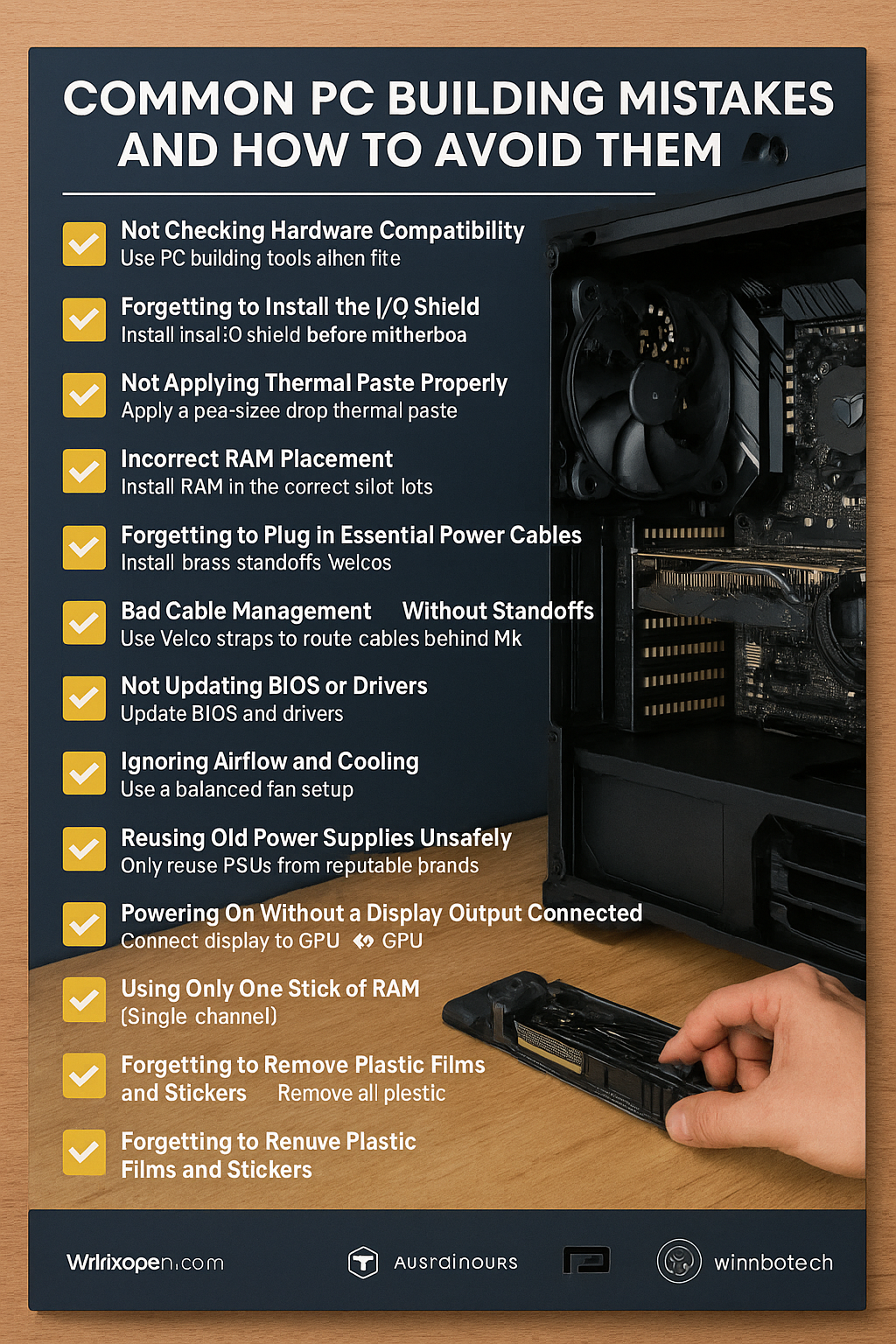Building your own PC is exciting and rewarding — but it’s easy to make mistakes that could cost you time, money, or even damage your components. Whether you’re a beginner or have experience, being aware of common pitfalls can help ensure a smooth, safe build.
In this article, we’ll cover the most frequent PC building mistakes in 2025 and how to avoid or fix them.
1. Not Checking Hardware Compatibility
Problem: Buying parts that don’t fit together.
Examples:
- Buying DDR5 RAM for a DDR4 motherboard
- Choosing a CPU not supported by your motherboard’s BIOS
- Getting a GPU too long for your case
✅ Solution:
- Use PC building tools like PCPartPicker to check compatibility
- Always consult your motherboard’s QVL list (for RAM and CPU support)
- Measure your case clearance for GPU and CPU cooler
2. Forgetting to Install the I/O Shield
Problem: You finish the build and realize the I/O shield is missing.
✅ Solution:
- Always install the I/O shield before placing the motherboard inside the case
- Some premium boards have pre-installed shields, which avoid this issue
3. Not Applying Thermal Paste Properly
Problem: Too much or too little thermal paste reduces heat transfer.
✅ Solution:
- Apply a small pea-sized drop in the center of the CPU
- Avoid spreading it manually or using excessive amounts
- If using a cooler with pre-applied paste, don’t add more
4. Incorrect RAM Placement
Problem: RAM sticks not in the correct slots or not fully seated.
✅ Solution:
- Always install RAM in dual-channel configuration (check motherboard manual)
- Listen for the click sound and ensure clips are locked in place
- Boot errors or no display often result from loose RAM
5. Forgetting to Plug in Essential Power Cables
Problem: PC won’t turn on or only fans spin.
✅ Solution:
Double-check:
- 24-pin motherboard power
- 8-pin (or 4+4) CPU power (often forgotten)
- PCIe cables for the GPU
- SATA power for drives
6. Installing the Motherboard Without Standoffs
Problem: The motherboard touches the case directly, causing shorts.
✅ Solution:
- Install the brass standoffs that come with your case
- Ensure each screw hole aligns with a standoff before securing the board
7. Bad Cable Management
Problem: Tangled wires restrict airflow and look messy.
✅ Solution:
- Use cable routing holes and Velcro straps
- Route cables behind the motherboard tray
- Plan cable paths before plugging everything in
Bonus: Good cable management improves airflow and makes upgrades easier.
8. Not Connecting Front Panel Connectors Correctly
Problem: The power button, reset switch, or LEDs don’t work.
✅ Solution:
- Refer to your motherboard manual for the front panel pin layout
- Carefully plug in:
- Power SW
- Reset SW
- HDD LED
- Power LED (+/- matters for LEDs)
9. Not Updating BIOS or Drivers
Problem: The system won’t boot with a newer CPU or works poorly.
✅ Solution:
- Update the BIOS before installing newer CPUs (if needed)
- Download and install:
- Chipset drivers
- GPU drivers
- LAN/Wi-Fi and Audio drivers
Keep them updated through manufacturer websites or Windows Update.
10. Ignoring Airflow and Cooling
Problem: High temperatures and fan noise.
✅ Solution:
- Use a balanced fan setup (intake + exhaust)
- Avoid cramming all fans as intake or exhaust
- Ensure proper orientation:
- Fans should blow air into the case from the front/bottom
- And out from the top/rear
Add filters to intake fans to reduce dust.
11. Reusing Old Power Supplies Unsafely
Problem: Underpowered or low-quality PSUs can damage components.
✅ Solution:
- Only reuse PSUs if:
- They are from reputable brands
- Less than 5 years old
- Have the correct wattage and connectors
Avoid cheap or no-name PSUs, especially with modern GPUs.
12. Powering On Without a Display Output Connected
Problem: You think your PC isn’t working, but the display cable is on the motherboard, not GPU.
✅ Solution:
- Always connect the monitor to the GPU, not the motherboard (if using a dedicated GPU)
- Use DisplayPort or HDMI, depending on your monitor
13. Using Only One Stick of RAM (Single Channel)
Problem: Lower performance in games and multitasking.
✅ Solution:
- Always use 2 or 4 sticks of RAM to enable dual or quad channel
- Even 2x4GB outperforms 1x8GB in many real-world tasks
14. Forgetting to Remove Plastic Films and Stickers
Problem: Plastic on heatsinks or SSDs can trap heat.
✅ Solution:
- Remove all protective plastic, especially from:
- GPU backplates
- Motherboard heatsinks
- SSD thermal pads
Final Tips: How to Build Like a Pro
✅ Take your time — never rush a build
✅ Work in a static-free environment and ground yourself often
✅ Keep a small dish for screws to avoid losing them
✅ Test the system outside the case (on motherboard box) if troubleshooting
✅ Celebrate your build — but double-check everything before first boot
Mistakes are part of learning, but with a checklist and awareness of common errors, you can build a PC like a pro. A little patience goes a long way toward a clean, safe, and powerful machine.
